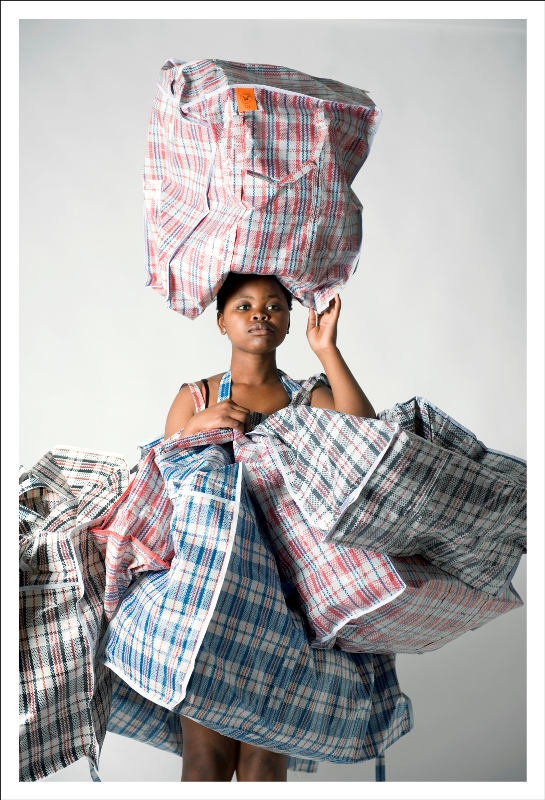
Nobukho Nqaba
South African, b.1992
Umaskhenkethe Likhaya Lam
2012
Photograph
South Africa
AKAA Art Fair, Paris, France
AFRS 2251 - ARTH 2360

Nobukho Nqaba
South African, b.1992
Umaskhenkethe Likhaya Lam
2012
Photograph
South Africa
AKAA Art Fair, Paris, France
The Philani Printing Project was started in 1997 in the township of Crossroads, South Africa by Xhosa female artists who combine art and feminist politics to end injustices they experienced in their lives. This project’s overall goal is to stop malnutrition and poverty among children by employing, educating, and empowering mothers. As part of this mission, women were trained in printmaking and then given the freedom to create artworks, which gave them an outlet for creative expression of social issues. Additionally, these women took a variety of classes, including “leadership and empowerment” and HIV/AIDS awareness classes. The featured works, Umanyano Ngamandla and Stop AIDS exemplify the power and creativity of the Xhosa women involved in this project.
Umanyana Ngamandla
The Philani Printing Project
2000
Acrylic on cotton
56 x 72 inches
This work made by women in the Philani Printing Project depicts a unified group of women taking political action and standing up for their rights in front of a large South African crowd. The cheerful disposition of the women and the overall bright coloring convey celebration and optimism. This piece offers an all-encompassing view of South African female activism through celebrating past South African women while calling for continued action and support today.
Stop AIDS
The Philani Printing Project
2000
Acrylic on cotton
56 x 72 inches
This piece calls attention to the urgent issue of HIV/AIDS which plagues South African women. The various people depicted represent activists of the AIDS crisis, all playing different roles to stop the devastating effects of this disease. Repeated patterns and symbols create a coherent narrative across the cloth about the female experience surrounding AIDS while conveying the seriousness of the situation through bright colors and textual information. This piece aims to educate viewers and demonstrate the artists’ fear and sadness towards the AIDS crisis, as the disease was common and destructive within their communities.
Helen Mmakgabo Sebidi (b. 1943, South African)
The child’s mother holds the sharp side of the knife
1988-89
Pastel on paper
73 1/2 x 110 1/4 inches
Iziko SANG collection
Starting Helen Mmakgabo Sebidi’s artistic career with depictions of rural life, she did not make artistic social commentary until the mid-1980s. Even once she shifted to illustrating experiences in an urban environment, Sebidi never self-identified as a feminist. However, Sebidi said her art aimed to demonstrate “the conflict between women and men, the past and the present.” Sebidi’s work expressed the conflicts and challenges presented to South African women during her lifetime. She put forward feminist ideals by presenting women as people with power and agency. This work depicts a woman pulling a chain amidst chaos, which demonstrates these ideals of female strength. This chain represents South African tradition, while the work as a whole symbolizes a woman’s responsibility to carry on tradition despite changing times. Therefore, Sebidi contributes to the feminist movement with a new perspective that views women as powerful beings having important cultural responsibilities.
Nina Romm (b. 1949, South African)
Untitled (photograph of performance)
Mid-1970s
Collection of the artist
Nina Romm’s work serves as one of the earliest examples of feminist interest and expression in South Africa. Like Siebert, whose work is also included in this exhibiton, Romm studied at the University of Cape Town for a Master of Fine Art degree. During her time in Cape Town between 1972 and 1975, Romm paid careful attention to the feminist movement in the U.S. and included this knowledge of feminist ideals in both her writing and artwork. Feminist underpinnings characterized her Dada-inspired performances, one of which is captured in this photograph. Romm demonstrates the under appreciated power of women through her strong, elevated stance and masculine, muscular pose.
 Kim Siebert (b. 1958, South African)
Kim Siebert (b. 1958, South African)
What did your mother ever tell you about the Hard Edge School?
1986
Photo collage on board with painted frame
Iziko SANG collection
Kim Siebert, a South African white woman, created this work in a series of collages exploring how modernism excluded and objectified women. Siebert made this series in the 1980s, serving as an early example of feminist art in South Africa. This domestic scene exemplifies public perception of female creativity as restricted to the home through activities such as interior design. Siebert references the male gaze through the phallic imagery of binoculars and pillars, critiquing the objectification of women in mediums such as magazines and films. Siebert says she hopes to focus “on personal history, cultural heritage and context” as well as “what it means to be perceived and to perceive the world as a woman artist in Africa.” Siebert’s inclusion of isiXhosa and isiZulu basketry and beadwork live up to these goals, as these patterns suggest that the diminishing of female art also applies to black, working-class women.